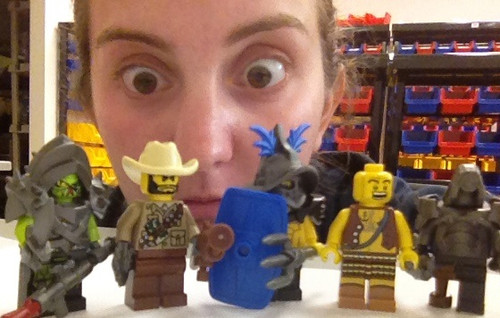The Brick Connection - FIRST LEGO League
Posted by Cori on 24th Mar 2016
The Brick Connection – A novice Lego fan explores the great brick world of LEGO
Holy Crap! How is it still March??
I mean….hello wonderful LEGO fans! I hope you are having a beautiful first week of Spring (or first week of Fall if anyone from the Southern Hemisphere happens to be reading this.)
While some of you young ones may be about to go on Spring Break, I am looking to get schooled……on the educational uses of LEGO. Specifically how LEGO can be used to get kids interested in STEM: Science, Technology, Engineering, and Math. And hopefully inspire them to pursue a career in one of those fields someday.
This is done with LEGO Mindstorms.
Hey, didn’t I talk about this two weeks ago?
Yes, but now I’ve seen Mindstorms educational use in action and I am very intrigued.
What intrigued me was an international competition for young
people called FIRST LEGO League, a program formed from a partnership between
FIRST and the LEGO Group.

FIRST (For Inspiration and Recognition of Science and Technology) is an international youth organization that operates multiple science competitions. It was founded in 1989 (a great year for the birth of organizations and people.) Its goal is to develop ways to inspire students in engineering and technology fields. The organization’s philosophy is based on the made-up word, coopertition, or cooperative competition.
FIRST and LEGO came together to create FIRST LEGO League in
1999. That year there were 975 teams for a total of 9,500 participants. Sixteen years later, the 2015 competition had over 233,000 participants making up over 29,000 teams. And there were 1,350 events that spanned 80 countries.

So what are the teams doing in these competitions?
Well the teams are made up of kids ages 9-14 (9-16 outside of the U.S.) who are guided by two or more adult coaches. (You can have up to 10 kids on each team.)
Every year the FIRST LEGO League announces a real-world scientific challenge for teams to research. For example, one year it was about improving quality of life for seniors. The team must research the topic and design or modify a solution for the challenge.
Each team is also given a LEGO Mindstorms kit. Using the kit, teams must build and program an autonomous robot that can perform theme-based “mission” tasks on a table-top playing field. Autonomous means it operates without a remote control.
Teams meet once or twice a week for a couple months leading up to the competition. This is when they will research and complete their project to be presented and when they will build and program the robot.
Here’s a quick video explaining FLL.
On competition day each team has three judged sections and a
live robot run to complete.
Core Values
The first session is where the teams are judged on how they work together and use the FLL Core Values (more about this later). Seems like a very subjective thing to judge if you ask me. But the judging is aided by the fact that each team is asked to perform a teamwork exercise. Judges can then see the teamwork or lack thereof in action.
Robot Design
Teams explain how they designed their robot and demonstrate their programs to the judges. (I’m trying to imagine my 9-year-old self confidently explaining to an adult how I programmed a robot…It’s too far-fetched even for my imagination. These kids must be geniuses!)
Project
Teams present their solution to the challenge given by FLL based on their research. They have five minutes to present followed by five minutes of questioning by the judges.
Finally, the fun part!
The team’s robot has two and half minutes to complete missions that are set up on a mat or board. To prepare for the day of competition teams get a practice field kit to use at their meetings that includes an exclusive selection of LEGO bricks. On the day of the competition there are a bunch of rules about how many people can oversee the robot and if you can “save” your robot and whatnot. It's intense stuff.
Here’s another video that goes into greater detail about how
the competition works:
Last year’s challenge for teams to take on was the Trash Trek Challenge:
From collection, to sorting, to smart production and reuse, there is more to your trash than meets the eye. Join FIRST LEGO League teams on a Trash Trek to discover the hidden (or not so hidden) world of trash!
The teams not only had to complete their research project on
trash, but program their robot to accomplish trash related missions for the
live robot run.
Check out this video of one team’s robot completing its
missions on the practice field. This gives you a good idea of the intricacies involved in completing
each task.
The next challenge will be announced officially on August 30,
2016. The title is Animal Allies. Without giving specific details yet, FLL is
asking teams to think about animals and “what might become possible when we
learn to help each other?” (Humans and animals that is.)
So what are the “Core values” of FLL that these kids
are being judged on? Well they’re quite simple actually:
We are a team.
We do the work to find solutions with guidance from our coaches and mentors.
We know our coaches and mentors don't have all the answers; we learn together.
We honor the spirit of friendly competition.
What we discover is more important than what we win.
We share our experiences with others.
We display Gracious Professionalism® and Coopertition® in everything we do.
We have FUN!
Overall FLL wants to stress that friendly competition and
mutual gain are not separate goals. I think that really strikes the perfect
balance for kids. There’s all this annoying talk these days that everyone gets a
participation ribbon just so kids don’t have to feel bad and that breeds a
generation of weak-minded individuals.
Well I think that’s greatly exaggerated, but also not completely off-base. Healthy competition is definitely a good thing to have, but wanting to win should never be about wanting other people to lose. And losing should not make you feel like your less than anyone, but motivate you to work harder for next time.
If you’re wondering how effective this
program is in creating a positive impact for kids in school, well FIRST LEGO
League has the results. According to FLL over 88% of participants are more interested
in doing well in school and 87% have more interest in attending college.
That’s great news and further proof that LEGO helps kids expand their minds and discover what they have to offer the world.
For more information on FIRST LEGO League you can go to
their website: www.firstlegoleague.org
The U.S. FLL website is here.
When looking up FIRST LEGO League in my area, I found out
that the First State FIRST LEGO League located in my hometown of Wilmington,
Delaware actually hosts the largest single-day robotics competition in the
world.
The competitions included are FIRST Lego League Jr. (grades K-3), FIRST LEGO League (grades 4–8), FIRST Tech Challenge (grades 9–12), FIRST Robotics Competition (grades 9–12), as well as robot sumo competitions.
You can check out First State FLL here and First State Robotics here.
So that was my look at FIRST LEGO League. Have any of you participated
in or observed this or similar competitions?
I kind of wish I had tried harder to learn about science and technology in school. And maybe getting involved with something like this would have motivated me to. I always loved learning math and working through problems, but with science, I was just content to memorize what I needed to pass a test and then move on.
But then again, if I had been good at science, I probably wouldn’t have gotten to write a weekly blog about LEGO. Everything happens for a reason!
I’ll see you next week, when it will finally almost be
April! (Stupid 31 days of March!)
Until next time………LEGO BATMAN TEASER TRAILER!!!
*Compliments, general feedback, and constructive criticism are welcome. Any haters that are gonna hate, hate, hate, hate, hate can go step on some Lego with their bare feet.*



